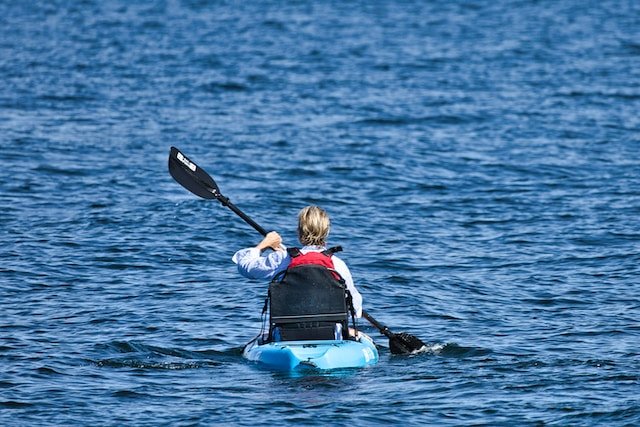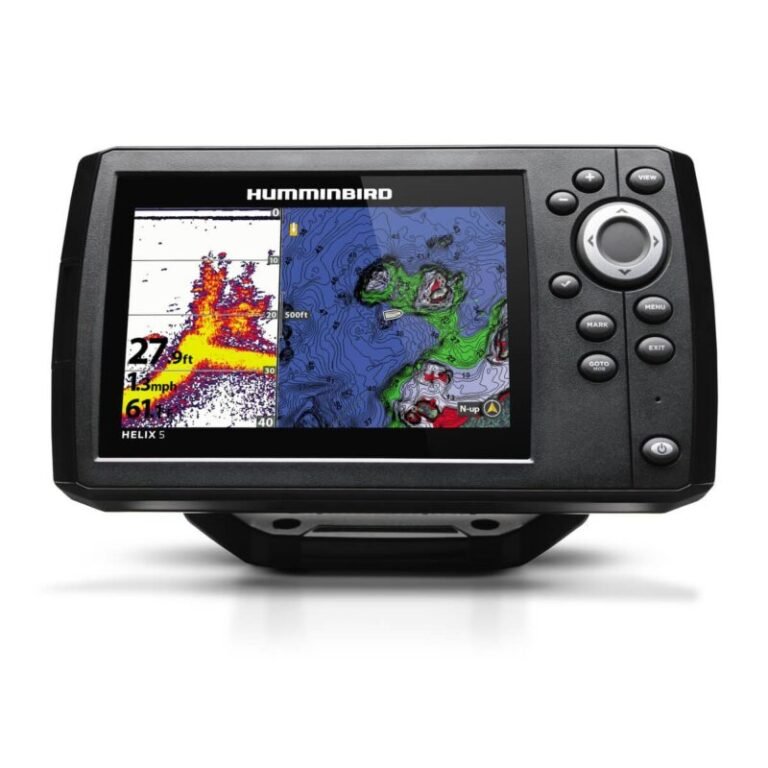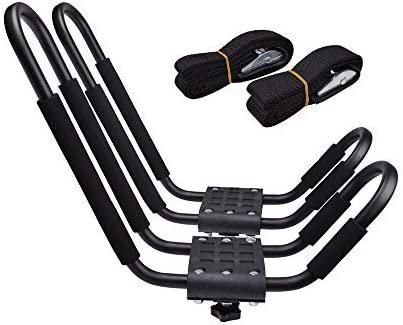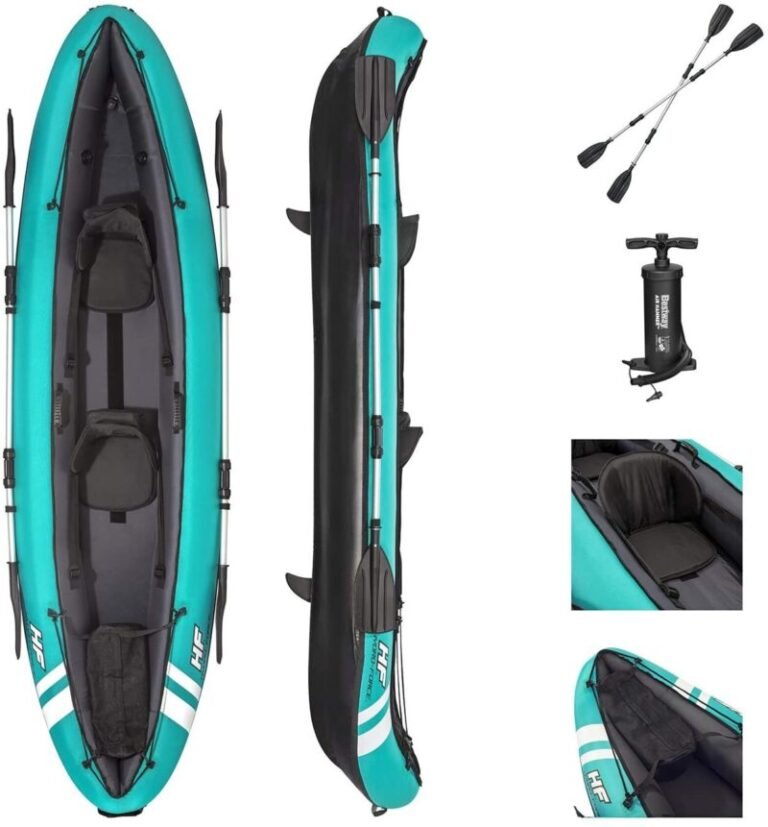How Much Wind Is Too Much For Kayaking?

Kayaking is a watersport whose popularity and adherents increase every day. The sport is a fun way to relax, spend time with close ones, work out, and see beautiful scenery. Kayaking can also be performed by people of any age or fitness level.
Kayaking like all things is not without risks. Safety on the water is paramount and the wind at certain times can cease being your friend and cause trouble. Kayaking and windy conditions can be a dangerous mix.
While kayakers are usually nimble and agile, the wind can quickly take them out of control. Even a small gust of wind can cause a kayaker to lose their balance and fall into the water. When conditions are windy, it is important to be cautious and aware of your surroundings.
Always wear a life jacket and stay vigilant when kayaking in rough or stormy weather. People who kayak in windy conditions should be aware of the risks involved. Wind can blow a kayaker off course and cause them to become stranded in treacherous waters.
A sudden gust of wind can also knock a kayaker overboard, and strong winds can carry a kayak away from its moorings. Kayakers should also be alert for hidden rocks and other obstacles in the water, which can cause serious injuries if they are hit by the boat, especially in windy conditions.
Effects Of Wind On Kayaking
Kayaking is a popular water sport that can be enjoyed by people of all ages and fitness levels. Kayakers use a variety of different types of kayaks, which can affect their experience depending on the wind conditions. How the wind affects kayaking is given below.
- When the wind is blowing strongly from one direction, it can create choppy water and make it difficult to paddle.
- When the wind is blowing evenly across all directions, it can help to propel the kayaker forward or make them more stable in the water.
- The wind directly affects the speed and direction of the kayak. Kayaking in wind contrary to your intended direction could end disastrously leading to capsizing or worse.
- The wind also creates noise and turbulence that can make kayaking difficult. The wind also has a significant impact on how well the kayaker can see and hear. When the wind is unfavorable, the kayaker will not be able to see his surroundings well or even hear warnings given to him by others on the water. This leaves the kayaker exposed to danger.
- The wind can push you sideways or lift you off the water, making it difficult to paddle in a straight line.
- The wind can suddenly and easily knock the kayaker overboard leaving him at the waves’ mercy and ruining the adventure.
Kayak Wind Speed
Kayakers are often curious about wind speeds while out on the water. Knowing the wind speed can help you determine whether or not it is safe to paddle in that direction.
Kayaks are typically not as stable in high winds, so knowing the wind speed is especially important for those who use kayaks for touring or racing. Additionally, knowing the wind speed can tell you how much power to use when paddling.
Generally, the greater the wind speed, the more challenging the kayaking experience. Just how fast is the average kayaker’s wind speed?
The average kayaker’s wind speed is between 7 and 15 miles per hour, with below 10 miles per hour being safe for beginners and below 15 miles per hour being safe for experienced kayakers on average. Kayakers using paddleboards can experience wind speeds up to 30 miles per hour!
How Much Wind Is Too Much For Kayaking?
The wind is one of the most important factors to consider when kayaking. Wind on the water can be a great asset when paddling, providing a smooth and bouncy ride.
However, too much wind can also be dangerous and potentially damaging to your kayak. You should always check the weather forecast before embarking on a kayaking trip.
Do not put all your faith in the reports however as wind speeds and directions can change rapidly in coastal areas. You have to keep an eye on your surroundings and retreat if the wind becomes too much before things go south.
How much wind is too much for kayaking depends on the kayaker’s experience and skill level. Beginners should not attempt to paddle in winds greater than 10 mph, while more experienced kayakers can handle winds up to 25 mph.
When choosing a kayak for windy conditions, it is important to consider the type of kayak, the size of the paddler, and the wind speed. In general, kayaks with a flat bottom are not as susceptible to the effects of wind.
They are particularly vulnerable however if the paddler is unable to brace against the waves and the kayak bounces around.
What Factors Should You Consider Before Kayaking In Windy Conditions?
Kayaking can be a great way to get some exercise, see some beautiful scenery, and make some new friends.
Windy conditions can make kayaking challenging, but with a little preparation and caution, you can have a great time. Here are some things to consider before hitting the water:
- Make sure your equipment is in good condition – Kayaks can be susceptible to damage in windy conditions, so make sure your watercraft is in good shape and all the accessories are working properly.
- Check the weather – Always check the weather before venturing out on the water. It can be difficult to judge wind strength and where it will hit you, but sometimes it’s easier to just wait until the morning or afternoon to go out kayaking.
- Check that your lines are ready to go – Make sure you have all the necessary equipment on hand and know how it works, too. If your kayak is set up correctly, then there should be no problems docking or getting back in.
- Know your kayak. If you’re not familiar with your kayak’s characteristics, be sure to do some research before heading out. It’s important to know how your kayak behaves in windy conditions and what adjustments you need to make.
- Make sure to bring a life jacket and sturdy shoes. Clothes to keep you warm are also a good idea. Avoid clothes made of cotton or similar materials as they dry slowly and rob heat from you leaving you in danger of hypothermia.
- If you want to kayak in windy conditions, consider going with a group or at the very least let someone know where you are going. The person will be able to come to your aid should things go south.
- Make sure you have the means to call for help should an emergency occur.
- Don’t take unnecessary risks.
Keeping the above in mind would ensure you are ready to have fun should you for whatever reason decide to kayak in windy conditions.
Tips For Staying Safe While Kayaking In Windy Conditions
Kayaking can be a great way to enjoy the outdoors and get some exercise, but it can also be dangerous if you don’t know how to stay safe in windy conditions. There are a few things you can do to stay safe while kayaking in windy conditions and they are enumerated below.
- Make sure to wear a life jacket and know how to properly use it.
- Always keep an eye on the wind direction and stay away from potential wind gusts.
- Be aware of your surroundings and don’t let your guard down.
- Make sure you have a sturdy and well-made kayak.
- Follow the guidelines of the kayaking association or organization you belong to.
- Be prepared to use any available safety equipment, such as a PFD, life jacket, and whistle.
- Use a waterproof map or GPS device to track your progress. This will help you figure out where you are and where you are going. It is important to know the area around you and stay within it at all times. Windy conditions in unknown territory can be dangerous.
- Don’t let the wind push you off course. If you feel the wind pushing you, get away from it.
- If you are in a kayak and have problems, don’t go out of your way to avoid other kayaks on the water. Not only will this put you in danger, but it will also make it harder for other kayakers to help you if something should happen.
- Always carry a cell phone with you and know how to use it in case of emergency.
- If you are getting tired or having problems, get off the water and rest. It’s best to call 911 before you go out on the water again.
- Always check the weather forecast before hitting the water. This will let you know the probable weather conditions and if the winds you will encounter will be safe for your adventure.
- If you are paddling with more than one person, check that all paddlers are facing the same direction.
- Never try to avoid a large wave by turning directly into it.
- Employ safe kayaking practices and obey all navigation rules on the water.
- Always have a backup plan in case of an emergency.
- Never paddle if the sea is too rough or the waves are too high.
The wind is an important factor to consider before embarking on a kayaking adventure as it plays a major role in whether the trip is safe or not. Kayaking in high winds can be dangerous.
While it may be tempting to head out into the windy conditions, it is important to be aware of the risks and take precautions to ensure a safe outing. Before embarking on a kayaking trip in high winds, make sure to check the weather forecast and be prepared for rough waters.
If you do choose to kayak in high winds, use caution and take measures to protect yourself from the elements, make sure you have the proper gear to deal with windy conditions.
Kayaking in windy conditions can be a lot of fun and while wind can make kayaking more difficult, it is not necessarily a bad thing. It just requires a bit of adjustment and practice.
The amount of wind that is too much for kayaking varies depending on the person and the conditions. It is important to be aware of the conditions around you on the water and to use common sense when deciding whether to kayak in windy conditions.
If the winds are too strong, it’s best to stay off the water; you can always kayak later. Remember to be safe on the water and have fun!






